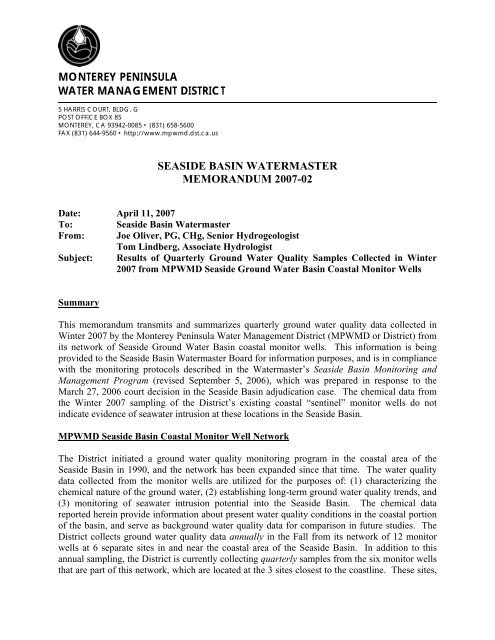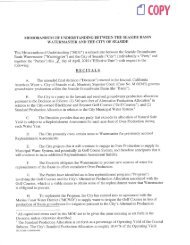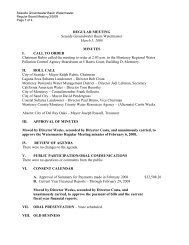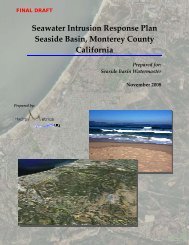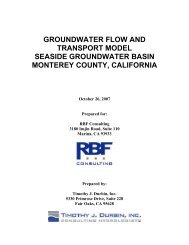seaside groundwater basin watermaster - Seasidebasinwatermaster ...
seaside groundwater basin watermaster - Seasidebasinwatermaster ...
seaside groundwater basin watermaster - Seasidebasinwatermaster ...
You also want an ePaper? Increase the reach of your titles
YUMPU automatically turns print PDFs into web optimized ePapers that Google loves.
MONTEREY PENINSULA<br />
WATER MANAGEMENT DISTRICT<br />
5 HARRIS COURT, BLDG. G<br />
POST OFFICE BOX 85<br />
MONTEREY, CA 93942-0085 • (831) 658-5600<br />
FAX (831) 644-9560 • http://www.mpwmd.dst.ca.us<br />
SEASIDE BASIN WATERMASTER<br />
MEMORANDUM 2007-02<br />
Date: April 11, 2007<br />
To: Seaside Basin Watermaster<br />
From: Joe Oliver, PG, CHg, Senior Hydrogeologist<br />
Tom Lindberg, Associate Hydrologist<br />
Subject: Results of Quarterly Ground Water Quality Samples Collected in Winter<br />
2007 from MPWMD Seaside Ground Water Basin Coastal Monitor Wells<br />
Summary<br />
This memorandum transmits and summarizes quarterly ground water quality data collected in<br />
Winter 2007 by the Monterey Peninsula Water Management District (MPWMD or District) from<br />
its network of Seaside Ground Water Basin coastal monitor wells. This information is being<br />
provided to the Seaside Basin Watermaster Board for information purposes, and is in compliance<br />
with the monitoring protocols described in the Watermaster’s Seaside Basin Monitoring and<br />
Management Program (revised September 5, 2006), which was prepared in response to the<br />
March 27, 2006 court decision in the Seaside Basin adjudication case. The chemical data from<br />
the Winter 2007 sampling of the District’s existing coastal “sentinel” monitor wells do not<br />
indicate evidence of seawater intrusion at these locations in the Seaside Basin.<br />
MPWMD Seaside Basin Coastal Monitor Well Network<br />
The District initiated a ground water quality monitoring program in the coastal area of the<br />
Seaside Basin in 1990, and the network has been expanded since that time. The water quality<br />
data collected from the monitor wells are utilized for the purposes of: (1) characterizing the<br />
chemical nature of the ground water, (2) establishing long-term ground water quality trends, and<br />
(3) monitoring of seawater intrusion potential into the Seaside Basin. The chemical data<br />
reported herein provide information about present water quality conditions in the coastal portion<br />
of the <strong>basin</strong>, and serve as background water quality data for comparison in future studies. The<br />
District collects ground water quality data annually in the Fall from its network of 12 monitor<br />
wells at 6 separate sites in and near the coastal area of the Seaside Basin. In addition to this<br />
annual sampling, the District is currently collecting quarterly samples from the six monitor wells<br />
that are part of this network, which are located at the 3 sites closest to the coastline. These sites,
MPWMD Seaside Basin Watermaster Memorandum 2007-02<br />
April 11, 2007<br />
Page 2<br />
described herein as the “MPWMD coastal sentinel wells”, are shown on Figure 1. At each of<br />
these 3 sites, a “shallow” and “deep” monitor well have been installed (either in separate<br />
boreholes or as multiple completions in a single borehole), generally corresponding to well<br />
completions within the two principal aquifer units in the Seaside Basin, known as the Paso<br />
Robles Formation (QTp) and Santa Margarita Sandstone (Tsm), respectively. The<br />
Pliocene/Pleistocene-Age QTp is a continental formation comprised of a fluvial mix of clay, silt,<br />
sand and gravel, deposited as ancestral valley fill sediments. The Miocene-Age Tsm is a marine<br />
and brackish-marine, fine- to coarse-grained arkosic sandstone, which overlies the shales of the<br />
Monterey Formation. The monitor wells are constructed of 2-inch PVC casing, with screens<br />
isolated in sand “packages” within each aquifer unit. The aquifer units are separated from each<br />
other in the wells by cement strata isolation seals.<br />
Water Sample Collection<br />
Water sample collection is accomplished by “air-lift” pumping. The method utilizes a 3/4-inch<br />
PVC dedicated airline in the well, which is coupled to an air compressor. The wellhead<br />
configuration is fashioned after that shown in Figure 2. Due to the small diameter of the<br />
monitor wells, the well casing is used as the “eductor” pipe, rather than a separate eductor pipe<br />
inside the well. Through experience, it has been determined that acceptable pumping results can<br />
be achieved if the bottom of the airline is placed at a depth that gives approximately 50 percent<br />
pumping submergence (i.e., the ratio of the length of the airline below the pumping water level<br />
to the total length of the airline). The air-lift method can be inappropriate for certain water<br />
quality constituents due to chemistry changes brought about by air entrainment in the purged<br />
water; however, it is considered appropriate for the suite of inorganic constituents that are<br />
currently analyzed from the collected samples.<br />
The volume of water removed from each well prior to sampling is generally three casing<br />
volumes, consistent with standard sampling protocol. Sampling is supplemented by field<br />
measurement of several indicator parameters that are collected during pumping, which ensures<br />
that water quality has stabilized prior to sample collection. Once the samples are collected, they<br />
are taken to a State-certified laboratory for analysis.<br />
Winter 2007 Quarter Water Quality Results<br />
Water chemistry analytical results for the quarterly ground water samples collected from the<br />
District’s six existing coastal “sentinel” monitor wells on January 30, 2007, are provided in<br />
Table 1. For comparison, the analytical results from the previous sampling of these same wells<br />
in Fall 2006 are provided in Table 2. Note that Table 2 also includes the chemical data for six<br />
additional monitor wells that are sampled annually from locations that are farther from the<br />
coastline.<br />
The chemical data from the depth intervals sampled at these monitor wells do not indicate<br />
evidence of water quality changes indicative of seawater intrusion at these locations in the<br />
coastal area of the Seaside Basin. Additional descriptions of the ground water quality results<br />
from the District’s Seaside Basin coastal monitor wells can be found in MPWMD Seaside Basin
MPWMD Seaside Basin Watermaster Memorandum 2007-02<br />
April 11, 2007<br />
Page 3<br />
Watermaster Memorandum 2007-01, as well as MPWMD Technical Memorandum 97-02. Both<br />
of these documents are available at the District office for review.<br />
U:\Joe\wp\SBWatermaster\2007\Winter2007WQresults_memo_11apr07.doc
MPWMD Seaside Basin Watermaster Memorandum 2007-02<br />
April 11, 2007<br />
Page 4<br />
Figure 1. MPWMD Seaside Basin Coastal “Sentinel” Monitor Well Locations.
MPWMD Seaside Basin Watermaster Memorandum 2007-02<br />
April 11, 2007<br />
Page 5<br />
Ground Water Quality Monitoring Results<br />
Tables
MPWMD Seaside Basin Watermaster Memorandum 2007-02<br />
April 11, 2007<br />
Page 6<br />
Table 1<br />
MONTEREY PENINSULA WATER MANAGEMENT DISTRICT<br />
GROUND WATER QUALITY MONITORING RESULTS<br />
Seaside Basin Sample Collection Date: January 30, 2007<br />
Units are milligrams per liter unless otherwise noted.<br />
Water Quality<br />
Constituent<br />
Specific<br />
Conductance<br />
(micromhos/cm)<br />
Total<br />
Alkalinity<br />
(as CACO3)<br />
pH Chloride Sulfate<br />
Ammonia<br />
Nitrogen<br />
(as NH3)<br />
Nitrate<br />
Nitrogen<br />
(as NO3)<br />
Nitrate<br />
(as NO3-<br />
N)<br />
Total<br />
Organic<br />
Carbon<br />
Calcium Sodium Magnesium Potassium Iron Manganese Orthophosphate<br />
Drinking Water Standard (1) 900 1600 2200 (2) NA NA 250 500 600 (2) 250 500 600 (2) NA 45 NA NA NA NA NA NA 0.3 0.05 NA<br />
Sampling Location<br />
15S/1E-15N3 (shal) 325 69 8.1 47 18 0.07
MPWMD Seaside Basin Watermaster Memorandum 2007-02<br />
April 11, 2007<br />
Page 7<br />
Table 2<br />
MONTEREY PENINSULA WATER MANAGEMENT DISTRICT<br />
GROUND WATER QUALITY MONITORING RESULTS<br />
Seaside Basin Sample Collection Date: October 24 and October 25, 2006<br />
Units are milligrams per liter unless otherwise noted.<br />
Water Quality<br />
Constituent<br />
Specific<br />
Conductance<br />
(micromhos/cm)<br />
Total Alkalinity<br />
(as CACO3)<br />
pH Chloride Sulfate<br />
Ammonia<br />
Nitrogen<br />
(as NH3)<br />
Nitrate<br />
Nitrogen<br />
(as NO3)<br />
Total<br />
Organic<br />
Carbon<br />
Calcium Sodium Magnesium Potassium Iron Manganese Orthophosphate Boron<br />
Drinking Water Standard (1) 900 1600 2200 (2) NA NA 250 500 600 (2) 250 500 600 (2) NA 45 NA NA NA NA NA 0.3 0.05 NA NA<br />
Sampling Location<br />
15S/1E-15N3 (shal) 320 72 7.8 46 17 0.06


